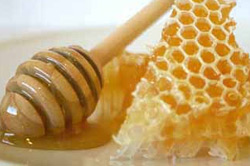Bees
Updated: September 14, 2020

Although there are about 10,000 different kinds of bees living in North America only the honey bee (Apis mellifera) produces honey. (There are several close relatives in other parts of the world that also make combs and produce honey, but they are generally not able to tolerate colder temperatures, and don’t always make their homes in cavities, which makes them hard to “domesticate” for people.) Honeybees live in large groups called colonies, in a beehive. Within each hive there are three types of bees: the single queen, drones, and workers.
The queen bee is the most important bee. Without her, the colony would not exist for very long. She lays all the eggs in the hive, which develop into larvae, then pupae, and finally, into adult bees. She also maintains social order by producing special chemicals in her glands. She can live for 5 or 6 years. When she reaches the end of her life, the worker bees sense that a new queen is needed, and change the food they give certain larvae, so they develop into queens instead of workers. Although several new queens are produced, only one gets to continue as queen, with the rest usually being killed by the first to emerge.
Worker bees also have a huge job. There may be thousands of these bees in a hive. When they first emerge from the pupa, they take care of the brood (eggs, larvae, and pupae), making “beebread” from honey, pollen, and glandular secretions, feeding the larvae, and cleaning. Older bees concentrate more on cleaning, until they begin to go outside the hive to collect nectar and pollen. The workers also produce wax to build the comb, and use water to cool the hive on hot summer days. Some workers also guard the nest entrance. Any time a honeybee stings, she has sentenced herself to death, as part of her internal organs remain embedded with the stinger.

All worker bees are females, although they do not mate, or usually lay eggs. If they lay eggs, it usually means the queen is either sick or dead. There are generally a few male bees, called drones, present in the hive. At the end of the summer, the workers may grab these bees and drag them out of the hive. Their only function is to mate with the queen, so unless the colony is swarming (because there is a new queen) these bees have no purpose.
In order to reproduce the colony, the bees will stop feeding the queen for a short period of time. Normally, she is too heavy to fly, with a very large abdomen. But after a few days, she is able to fly again, and a portion of the bees in the hive, after filling their stomachs with honey, will fly out of the hive, with the queen. The swarm may light on a branch or in some other place, with the queen in the middle of the colony. The bees are usually very gentle at this time, although they do present an amazing spectacle, with bees almost literally dripping down from the main mass! The hive usually has three floors. The first floor is where the queen bee lives. She lays her eggs here and when they hatch the first floor becomes a nursery. The young bees stay here until they reach working age. On the second floor the winter supply of honey is stored. The bees use this supply to feed on as they cannot collect honey in the winter and would otherwise starve. Extra honey is stored on the third floor. This is where people harvest honey from. Honey collectors wear special protective clothing and face guards to prevent getting stung.
Bees make honey by collecting nectar from flowers. The bees suck up the nectar with their long tongues, and store it in a special honey stomach (called the crop). When the crop is full, the worker flies back to the hive, and transfers the nectar to other workers (hive bees) or into the cells of the hive.
Thank you to Department of Agriculture for providing this information.
Updated: September 14, 2020

